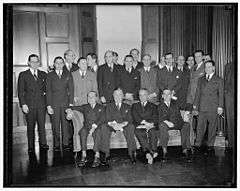Edward John Noble

Edward John Noble (1882 – 1958, aged 76) was an American broadcasting and candy industrialist originally from Gouverneur, New York. He co-founded the Life Savers Corporation in 1913. He founded the American Broadcasting Company when he purchased the Blue Network in 1943 following the Federal Communications Commission's (FCC) decree that RCA divest itself of one of its two radio networks.
Edward Noble was born in Gouverneur, New York and educated in the public schools. He attended Syracuse University and graduated from Yale in 1905.
In 1912, chocolate manufacturer Clarence Crane of Cleveland, Ohio invented Life Savers as a "summer candy" that could withstand heat better than chocolate. Since the mints looked like miniature life preservers, he called them Life Savers. After registering the trademark, Crane sold the rights to the peppermint candy to Edward Noble for $2,900. Instead of using cardboard rolls, which were not very successful, Noble created tin-foil wrappers to keep the mints fresh. Pep-O-Mint was the first Life Savers flavor.
He was the first chairman of the Civil Aeronautics Authority. He also served as secretary of Commerce under President Franklin D. Roosevelt, 1939-1940. Following the Federal Communications Commission's order that RCA divest itself of one of its two radio networks, he founded the American Broadcasting Company (ABC) when he purchased the Blue Network (formerly part of NBC) on October 12, 1943.[1] Noble tried valiantly to build ABC into an innovative and competitive broadcaster, but was hampered by financial problems and the pressure of competing with long-established NBC and CBS, and by 1951 was forced to enter negotiations to merge the network with United Paramount Theaters, headed by Leonard Goldenson; Goldenson would become chairman of the ABC network, while Noble remained on the ABC board of directors for the remainder of his life.
In 1943, Edward John Noble bought the St. Catherines Island on the coast of Georgia; in 1968, ten years after his death, the island was transferred to the Edward J. Noble Foundation.
The island is now owned by the St. Catherines Island Foundation, and the island's interior is operated for charitable, scientific, literary, and educational purposes. The foundation aims to promote conservation of natural resources, the survival of endangered species, and the preservation of historic sites, and to expand human knowledge in the fields of ecology, botany, zoology, natural history, archaeology, and other scientific and educational disciplines.
Noble was part of the St. Lawrence Seaway Project and was appointed to the advisory board by President Dwight D. Eisenhower in 1954. He owned Boldt Castle, the Thousand Island Club, and a summer residence on Wellesley Island. The ornamental street lights in the village park are all that remain of the gift of new street lights that were given to the village by Edward and his brother, Robert. The lights were in memory of their father.
Edward Noble died peacefully in his sleep on December 28, 1958.[2]
Three hospitals and a foundation are named after him.
In Rocksteady Studios' most recent and final installment of the Batman Arkham video game series, Batman Arkham Knight, there is a possible dual reference to Edward J Noble and Arkham Knight 3D artist Edward Noble.[3] After entering the tower from Bruce Wayne's office balcony, a plaque recognizing either (or both) Noble(s) can be found beside a model of Wayne Tower in the receptionist lobby. It reads "Wayne Tower & Plaza Architecture by: Edward Noble" followed by a model credit to "Martin Teichmann" (a Rocksteady Studios Environment Artist).[4]
References
- ↑ "Approves Buying of Blue Network," The New York Times, Wednesday, October 13, 1943.
- ↑ "Deaths: Edward John Noble". Daytona Beach Morning Journal. December 29, 1958.
- ↑ "Edward Noble" https://edwardnoble.wordpress.com/about/
- ↑ "Martin Teichmann" https://www.martinteichmann.com/aboutme.htm
External links
- E.J. Noble Hospital in Gouverneur, NY
- Edward John Noble Foundation company information from BusinessWeek